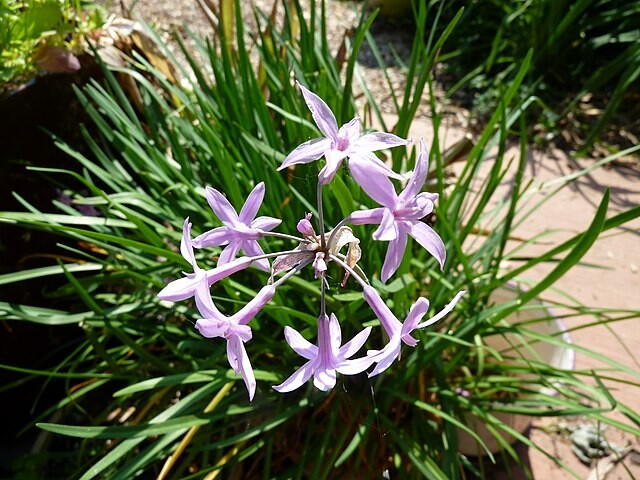Written by Don Richardson



Any reference to medicinal or culinary use of plants or plant parts should in no way be considered an endorsement by The Ocala Food Forest or its staff. Research is crucial in safe and proper consumption or experimentational use of any plant.
Tulbaghia Violacea, also known as society garlic or wild garlic, is a beautiful flowering plant that belongs to the Amaryllidaceae family. This plant is native to southern Africa and has become popular in gardens worldwide due to its striking purple-pink flowers, attractive foliage, and ease of care.
Here's what you need to know about growing and caring for Tulbaghia Violacea:
- Family: Amaryllidaceae
- Plant type: Herbaceous perennial
- Food Forest Plant
- Growth habit and mature size: Clumping habit, reaches 1 to 2 feet in height and width.
- Sun exposure requirements: Full sun to partial shade
- Soil type and pH range: Well-draining soil with a pH range of 6.0 to 7.5
- Moisture needs: Moderate, avoid overwatering.
- Seasons of bloom: Blooms in summer to fall.
- Native plant to: Southern Africa
- Native range in the USA: Not native to the USA, but widely cultivated in many states.
- Hardiness zone: 7a to 10b
- Temperature tolerance: Tolerates heat and drought, but may die back in winter temperatures below 10°F
- Does it self-pollinate? Yes
- Is it an edible plant? Yes, the leaves and flowers have a mild garlic flavor and can be used in cooking.
- Is it a medicinal plant? Yes, Tulbaghia Violacea has been used in traditional medicine for various ailments including coughs, colds, and stomach problems.
Landscape uses: Tulbaghia Violacea is a great addition to any garden due to its beautiful flowers and foliage. It can be planted in garden borders, rock gardens, and containers. It also attracts pollinators such as bees, butterflies and moths.
Growing tips: Tulbaghia Violacea prefers well-draining soil and moderate watering. It can be propagated through division, seeds, or cuttings. It's important to avoid overwatering and to protect the plant from winter temperatures below 20°F. May die back in cold winter temperatures. However, it will usually regrow from the roots in the spring.
Pest & diseases: Tulbaghia Violacea is relatively pest and disease-free. However, it may be susceptible to fungal diseases in humid conditions.
Cautions: While Tulbaghia Violacea is generally considered safe for consumption, some people may experience allergic reactions. It's always important to test a small amount of any new food before consuming it in larger quantities.
In conclusion, Tulbaghia Violacea is a beautiful and easy-to-care-for plant that will add color and fragrance to any garden. With proper care and attention, it will thrive and reward gardeners with its stunning blooms and versatile uses.









0 Comments